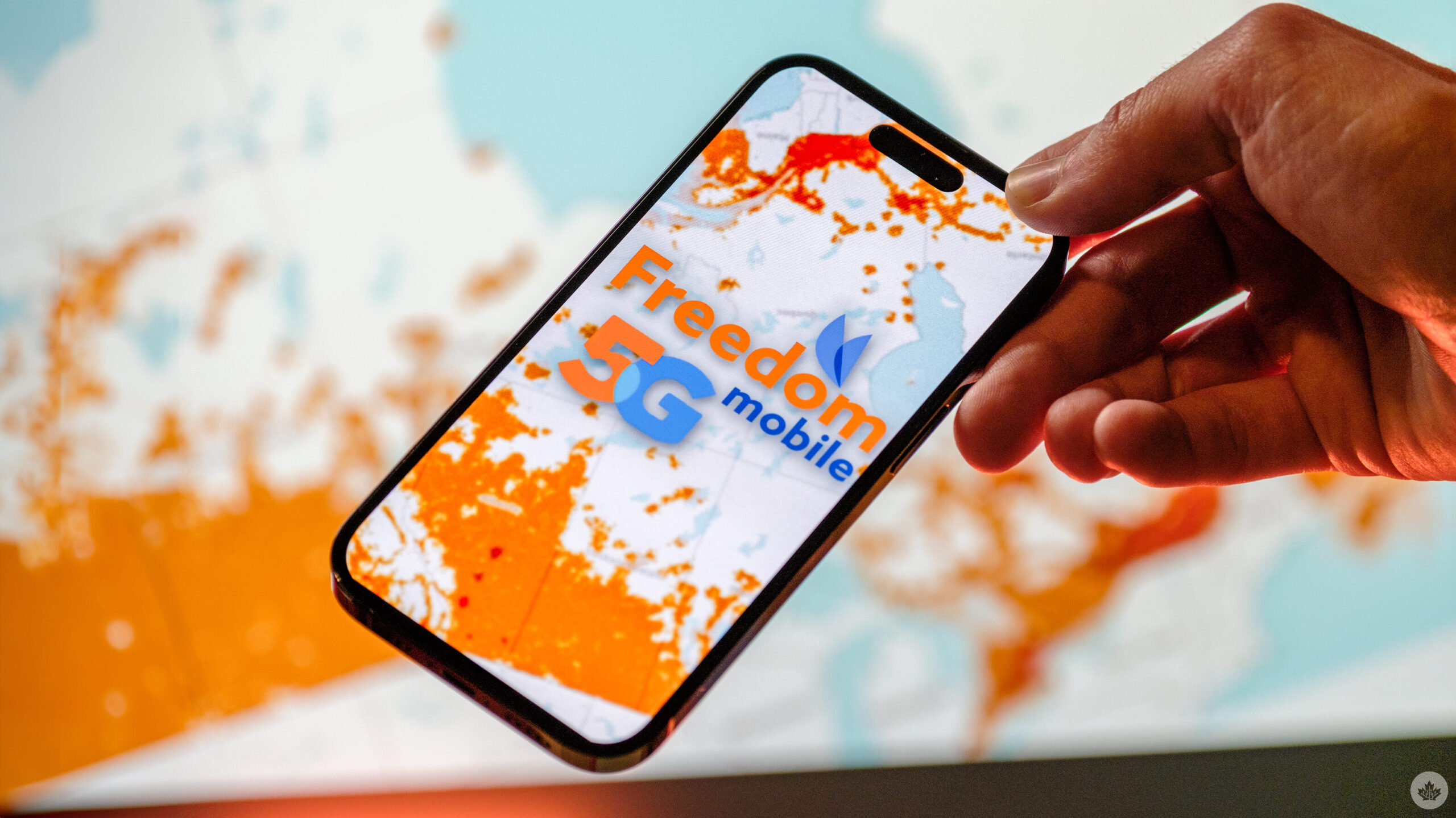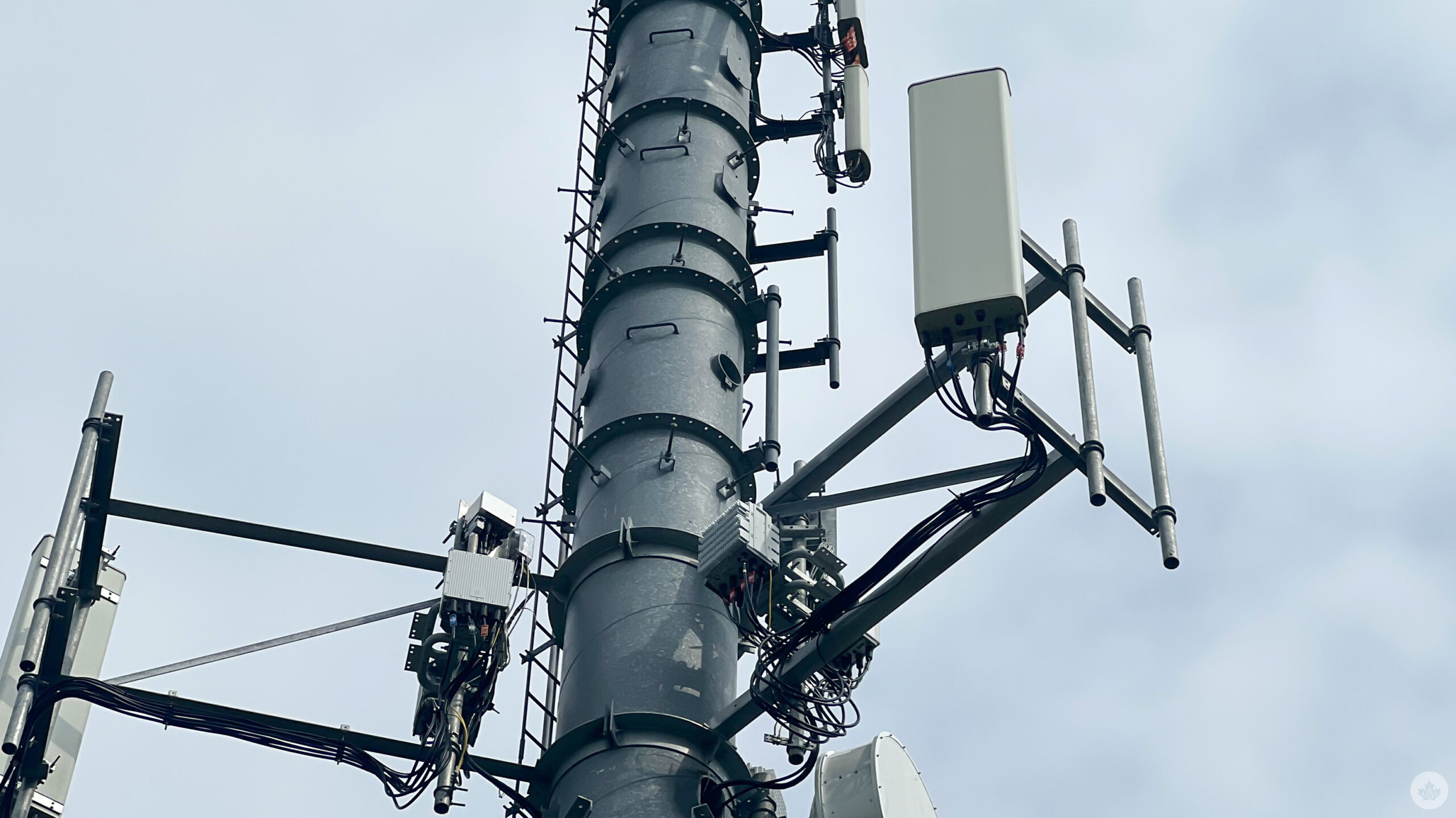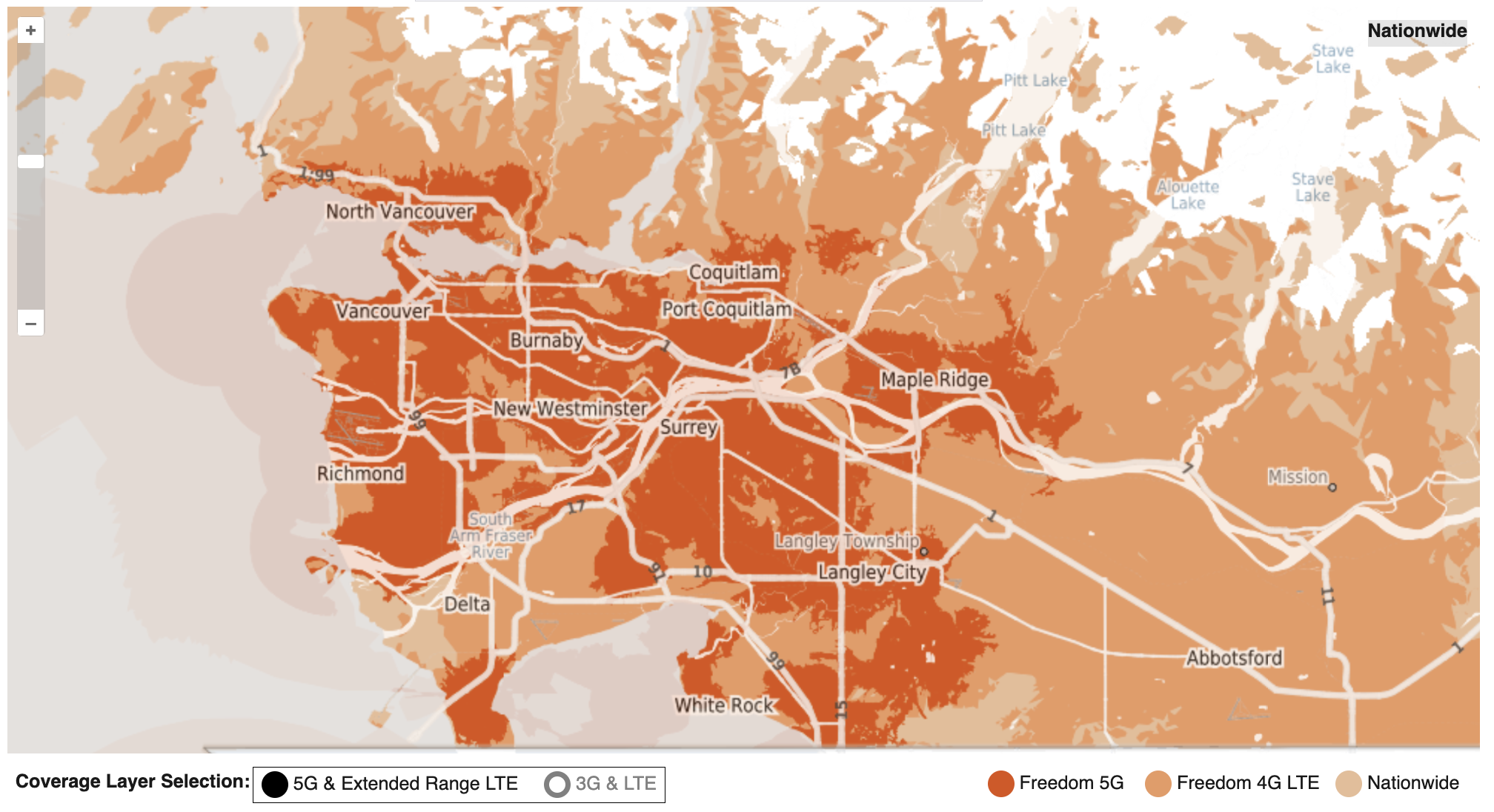
Freedom Mobile rolled out its 5G network earlier this year under Vidéotron. The deployment was notable for a few reasons, but perhaps the most significant was that Freedom’s pricing for 5G plans was cheap, at least compared to the big three.
Since the Freedom 5G launch, several other providers have deployed 5G plans, some of which approach the costs of Freedom’s options. Notably, Telus-owned Koodo and Public Mobile. and Bell-owned Virgin Plus launched 5G options.
The sudden proliferation of 5G services and, particularly, Freedom’s cheaper options had the MobileSyrup team wondering if Freedom was a more viable option now. Several team members previously used Freedom (or Wind back in the day) and ended up returning to one of the big three or their flanker brands. MobileSyrup’s news editor Jon Lamont, for example, tried Freedom in late 2015 and ended up breaking his contract to return to Koodo because of network performance issues.
MobileSyrup hit up Freedom and got a few SIM cards to take the new 5G network for a spin and see if it’s in a better position to serve our needs.
Since the MobileSyrup team generally lives in the Greater Toronto Area (GTA), most of our testing focuses on Toronto and surrounding areas. Unfortunately, for those living elsewhere, the below data won’t be as beneficial, but perhaps the anecdotal experiences may give you some insight into the Freedom experience.
Network overview
Before we dive into MobileSyrup’s experience trying out Freedom 5G, let’s look at some of the specifics.
Freedom’s 5G network doesn’t cap its 5G speeds, a spokesperson confirmed to MobileSyrup, unlike other providers. Telus, Rogers, and Bell all introduced speed caps to their plans in recent years, and those restrictions have since expanded to flanker brands too.
“Freedom largely occupies the center of our results, offering slower speeds than Bell or Rogers but still putting up some respectable numbers compared to Koodo and Fido”
However, Freedom’s website does detail how much access customers have to 5G data. After customers use the amount allotted through their selected plans, they access data at slower speeds. This has become a common practice across Canadian wireless providers.
Through the Freedom Network, it’s up to 256 kilobits per second (Kbps) for downloads and 128Kbps for uploads. Through Freedom’s partner networks, speeds are limited to 128Kbps for download speeds and 64Kbps for upload.
Freedom Mobile has its own network in parts of Ontario, B.C., and Alberta. Outside of these areas, it uses the network of other carriers to provide coverage. Freedom Mobile told MobileSyrup they have “several roaming partners across Canada.” As previously reported, negotiations for Rogers’ $26-billion takeover of Shaw saw Rogers as one of the possible partners.

Minister Champagne approved the Rogers-Shaw and Freedom-Vidéotron acquisitions on March 31st, 2023. Image credit: @FP_Champagne/X
Freedom’s parent company, Québecor, recently announced the extension of the company’s services as a Mobile Virtual Network Operator (MVNO). Under the framework, smaller companies can use the networks of incumbent providers to offer services in areas where they don’t have their own infrastructure.
Recent rulings from the Canadian Radio-television and Telecommunications Commission (CRTC) revealed Québecor has agreements with Rogers and Bell. The companies required the commission’s arbitration process to determine payment rates after they could not agree to access rates on their own.
Freedom Mobile launched its 5G network in July, over three months after Vidéotron acquired the company’s wireless licenses from Shaw, a crucial move for Rogers to get final approval for the merger.
At launch, the company announced its 5G network was available in Toronto, Vancouver, Calgary, Edmonton and surrounding areas.
According to Freedom’s coverage map, parts of several Southern Ontario municipalities receive coverage at this time. In B.C., parts of municipalities surrounding Vancouver, including Burnaby, Port Coquitlam, and Langley City, are also on the coverage list.
Under its agreement to acquire Freedom, Québecor said it would invest more than $150 million to upgrade the company’s infrastructure, which would let 90 percent of its customer base access its 5G network by April 2025 through a compatible device. At launch, the company said it is “ahead of schedule” on this front. A Freedom spokesperson further confirmed to MobileSyrup that “Québecor remains fully committed” to the obligation.
MobileSyrup also asked which devices would have the best experience on the network. While Freedom didn’t name specific brands, it said it does regular testing to ensure devices work “optimally” on its network. “Therefore, as long as customers have a 5G phone with a 5G plan and a 5G compatible SIM card, they should be able to access Freedom’s 5G network where available.”
Freedom’s 5G isn’t crazy fast, but it’s cheap
For the sake of this piece, MobileSyrup focused testing on upload and download speeds. It’s worth noting these aren’t the only metrics that matter but are approachable and easy to measure and quantify. Some other metrics that aren’t as easily measured are mentioned in the personal anecdotes below.
Moreover, the testing tried to capture a wide range of devices and providers, though MobileSyrup was unfortunately limited to testing against providers that team members already had access to. The tests weren’t about determining who has the best overall 5G, but instead to see how Freedom would compare to what team members were already using.
Freedom largely occupies the center of our results, offering slower speeds than Bell or Rogers but still putting up some respectable numbers compared to Koodo and Fido. However, even within Toronto, there’s a fairly broad range of results for Freedom, indicating consistency can vary pretty significantly based on where you are and even when you test.
For example, different tests of Freedom 5G using the Galaxy S23 Ultra in the same location saw notably different download speeds of 102Mbps and 69Mbps, while upload speeds were slightly more consistent at 23.2 and 28.3Mbps, respectively.
 MobileSyrup’s tests also included Union Station because many Ontarians pass through the station daily on their way to and from work. Results showed Freedom’s cell service typically took a hit there as service dropped from 5G to LTE+ and speeds reduced.
MobileSyrup’s tests also included Union Station because many Ontarians pass through the station daily on their way to and from work. Results showed Freedom’s cell service typically took a hit there as service dropped from 5G to LTE+ and speeds reduced.
Looking at tests outside of Toronto, there are some other notable results. For example, tests performed by Patrick O’Rourke in Burlington saw Freedom 5G barely beat Koodo 5G in download speeds, but Freedom got significantly higher upload speeds. While the Burlington score is a bit of an anomaly regarding how fast the upload speed was, Freedom’s upload speeds were fairly good across most tests, even beating out Rogers and Bell in some cases.
However, testing Jon Lamont did in Whitby saw Freedom 5G and LTE losing out to Fido LTE. It was a bit of a surprise, given Freedom has some 5G coverage in the area, though it’s not extensive. Meanwhile, tests Jon performed in Brechin, Ontario, saw Freedom beat out Fido LTE+ while roaming on a partner LTE network.
Overall, it seems that Freedom can hold its own against the flanker brands in Toronto but loses consistency outside of the city, even if you’re still on the Freedom network. Though we didn’t test as extensively on Freedom’s partner networks, performance there also seems solid. Given that Freedom manages to match or undercut the pricing of several other providers, it might be worth taking a hit to network performance to save some money.
Finally, it’s worth noting that Freedom’s network is set to improve going forward. Of course, no one should buy a service based on the promise of future improvements, but assuming Vidéotron holds up its end of the bargain, Freedom should get better over time.
How MobileSyrup team members found the experience
Jon Lamont - News editor
There were two big things I wanted to see with my Freedom testing. First, I was curious to see how much Freedom’s network had improved since I last used it in 2015. I also wanted to see if Freedom’s 5G offered a big enough performance bump that I could justify leaving Fido behind.
To the first part, Freedom does seem better now, but I wouldn’t consider it great. The last time I used Freedom, I lived in Pickering, Ontario, and barely had service there. Now I’m further east in Whitby and have useable, albeit not great, service.
I was pleasantly surprised about the network performance when I visited my family in Brechin. I expected the partner network to perform much worse than it did. That gives me hope that if I did switch to Freedom, I would still be able to use my phone even when I leave Freedom’s coverage area.
As for the second part, my testing with Freedom’s network showed that I could switch and generally have better performance, or in worst-case scenarios, slightly worse performance than with Fido. The main reason I’m with Fido is because I took advantage of the $45/50GB Black Friday promo last year, and I haven’t yet seen anything worth switching to. Plus, with Black Friday looming, I’m committed to waiting for deals on 5G before I make a move.
That said, I’ll strongly consider going with Freedom when the time comes. We’ll see what happens on Black Friday, but right now, Freedom has a $50/mo 50GB 5G plan that includes U.S. usage. In other words, for $5/mo more than what I pay to Fido, I could get 5G service and save a ton on roaming when I travel to the U.S., something I do frequently for work.
Nida Zafar - Telecom reporter
As MobileSyrup’s telecom reporter, I spent a lot of time covering Rogers’ acquisition of Shaw and Vidéotron’s purchase of Freedom Mobile. When Vidéotron agreed to invest millions in Freedom’s infrastructure, allowing for the launch of its 5G network, I was interested to see if it would stand up to the others. After all, one of the main selling points that allowed Vidéotron to take over the company was the argument that Freedom would help it become a fourth national player, going up against Bell, Telus and Rogers.
I'm a resident of Toronto, and I knew Freedom’s 5G network would directly apply to me, and I was expecting a smooth experience. As a Rogers customer who always has 5G/5G+ access through my iPhone 13, I felt like I had a solid base to compare it to.
While using Freedom’s 5G network via the Galaxy S23 Ultra at home and work, I didn’t notice much of a difference between it and Rogers. It loaded web pages quickly, allowed for easy scrolling through social media, and offered a smooth overall experience.
But things shifted when I tested the network while visiting the neighbouring town of Ajax, Ontario. While it still didn’t take long to load web pages, the action wasn’t instant. Using the device throughout the day in Ajax cemented the fact that where I live and work greatly impacted the speed of Freedom’s 5G network.
So, while I think the network’s speed is great in my case, it might lag for others living just outside of major cities that offer the network. I acknowledge this might not matter for most people, as waiting a couple of extra seconds to access a web page isn’t an issue, especially if it comes with a lower price tag.
I look forward to seeing if Québecor keeps its promise to expand Freedom’s 5G network.

Freedom's coverage in parts of B.C. Image credit: Freedom
Patrick O'Rourke - Editor-in-chief
For the past few months, I’ve encountered tremendous difficulty with my Telus-powered Koodo connection, with my issues starting shortly before Telus started offering 5G with Koodo.
At my home in Burlington, Ontario, I get one bar of signal if I’m lucky. Usually, I have zero bars, leading to dropped calls and a painfully slow data connection, whether I’m on LTE or 5G. I’ve reached out to Koodo as a customer and a journalist and was told there are no issues in my area despite there obviously being some sort of problem (I’ve lived here for four years and didn’t always encounter signal issues).
So when Freedom Mobile launched 5G, I was instantly intrigued. Could the Vidéotron-owned carrier be my saviour? At least when it comes to my data connection, probably not. I hit 133Mbps down and 66Mbps up with Freedom (I had between three and four bars of signal), while Koodo hit 124Mbps down and a measly 1.29Mbps upload (I don’t really care about upload speeds when it comes to my smartphone’s data connection).
In real-world use, I didn’t notice much of a difference. However, in my few hours using the Freedom Mobile SIM, calls dropped far less frequently and were far clearer, so perhaps that’s reason enough for me to make the switch.
Brad Bennett - Head of creative
I’m a notorious plan swapper who’s always on the hunt for a good deal. I currently live in Toronto, but my parents live in Renfrew, Ontario, and I travel there a few times a year and want to make sure I have reliable data when I’m there. As Freedom expanded its plan offerings to include Canada-wide data over the years, I was intrigued but never sure if it would work for me. When Jon and Nida mentioned that they had some SIM cards to test, I jumped at the chance.
Testing the Freedom SIM card on my Pixel 7 Pro in Toronto went well with no real issues. While Freedom’s 5G network in the Pixel never matched how fast my Rogers 5G service was in my iPhone 14 Pro, I didn’t notice any differences in day-to-day use. YouTube still streamed, apps downloaded fairly quickly, and websites sprung to life when loaded. On average, I was getting download speeds from 20-80Mbps.
However, the real test was in Renfrew, a small town about 100km northeast of Ottawa. While there, I had to ensure I enabled roaming on the Freedom SIM card, but I knew that was all part of the plan. The only hitch was that I wouldn’t be using 5G and instead would be on Rogers’ LTE network.
The phone worked flawlessly and surprisingly would hit maximum download speeds of 200Mbps. Not only were Freedom’s speeds faster than the 5G I was getting in parts of Toronto, but it was also faster than the so-called 5G I was getting in Renfrew from Rogers, which would max out at around 50Mbps.
This left me a bit confused, but overall, I'm satisfied that I can now start to seriously look at Freedom’s plans as a viable fourth option from Bell, Rogers and Telus when I want to get a better phone deal. And by the looks of things, that might be soon. My current Rogers plan is $82 per month with 110GB of Canada+U.S. data and the cellular smartwatch add-on. Right now, if I switched to Freedom, it would cost me $55 for 50GB of Canada+U.S. data and the Apple Watch add-on. It's a pretty steep discount that I would 100 percent take advantage of right now if Black Friday wasn’t right around the corner.
Help us collect data
To wrap things up, we also want to put out an ask to readers. As mentioned above, the MobileSyrup team resides primarily in Ontario and mostly around the GTA. However, Canada is a big place, and there are plenty of perspectives and experiences we can’t capture alone.
If you have a smartphone and a data plan, we’d love it if you could help us expand our testing footprint by evaluating your network performance and sharing it with us via the Google Form below.
Loading…
With files from Nida Zafar, Jon Lamont, Patrick O'Rourke and Bradley Bennett.
MobileSyrup may earn a commission from purchases made via our links, which helps fund the journalism we provide free on our website. These links do not influence our editorial content. Support us here.


